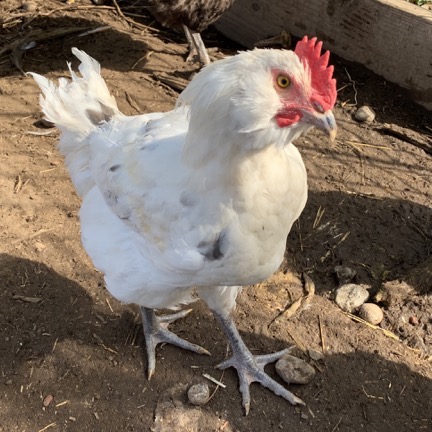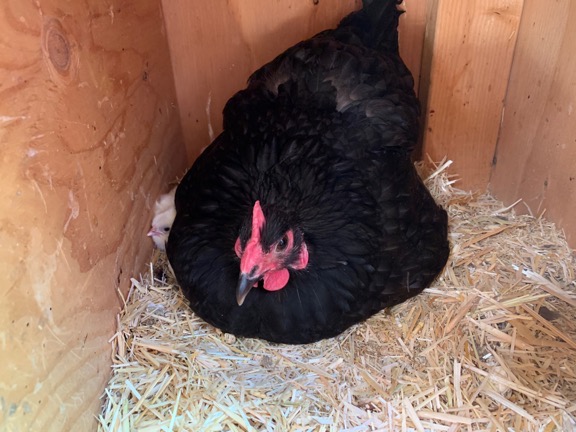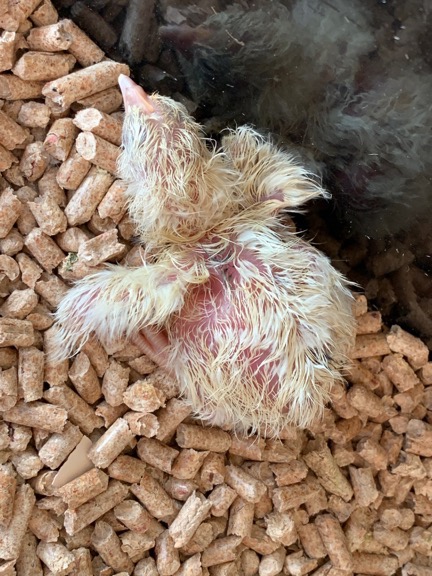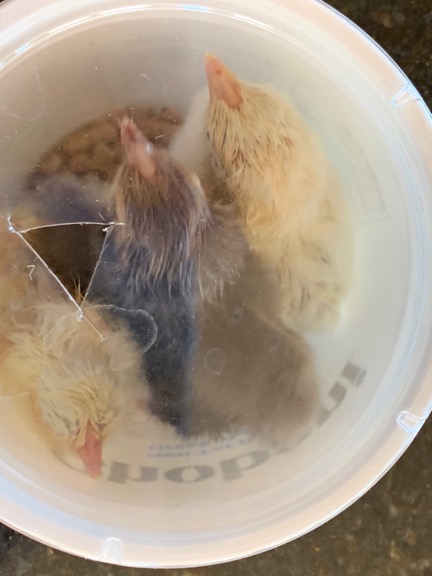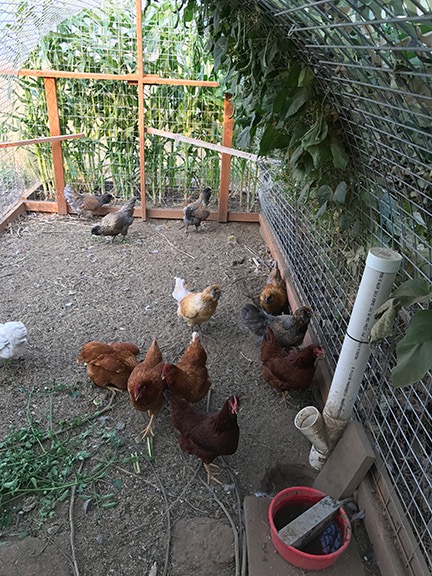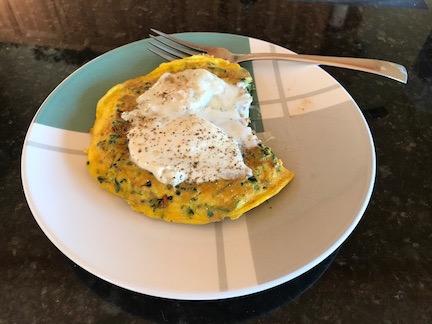I help a broody hen hatch 12 eggs.
Right around the time I returned from my vacation in early May, one of my hens got broody. A broody hen, in case you’re not familiar with the term, is one who wants to sit on eggs so they hatch and she can have chicks.
Although I’ve had chickens on and off for at least fifteen years, I’d never had a broody hen. The trouble with a broody hen is that she doesn’t lay eggs. She just sits on them. Worse yet, some of the other hens will lay eggs where she’s sitting so you don’t get eggs from those hens either. If you have chickens for eggs — which is why I have them — you don’t want a broody hen.
But I figured I’d let her sit until she got bored. She was sitting in the upper nest closest to the coop door and was in there every day that I peeked in to gather eggs.
And then one day, she was sitting on the nest farthest away from the coop door, leaving all her eggs — about ten of them — exposed and cold.
For some reason, I decided to take the eggs and stick them in my incubator. I set it up in the garage, added water to keep the humidity sensor happy, put a box of cat food cans on top to secure the lid, and forgot about it.
Until about four days later when she switched back to the first nest.
I gathered up the neglected eggs and added them to the incubator. At that point, I had 18 eggs in there.
Becoming a Chicken Mama
Life went on. She kept sitting on eggs in that first nest. I kept trying to pull the eggs out from under her, trying to discourage her from sitting.
And then one evening about 18 days after starting the incubator (according to the incubator’s clock), I went down to check the incubator and heard a chick. I saw the broken egg but didn’t see the chick right away. Turns out it had fallen off the platform where the eggs were in their turner and fell into a tiny crevice that normally would be full of water. Fortunately, I’d put water on one side only.
I had to take the incubator apart to get it out. Then I had to set up a warm place for it to brood. I had a chicken heater and a clear plastic bin and some pelleted litter material. Within minutes, I had a place set up on my dining table for the squawking little bird. Then I went back to the garage, put the incubator back together and put the eggs back.

Here’s the first chick that hatched, along with two pipping eggs. Can you see the cracks? The black thing is a heater that won’t burn the birds (or anything else).
That’s when I noticed that three more eggs were pipping. That means they had tiny cracks caused by the chick trying to get out. I brought them upstairs and set them in the warm bin with the other chick, which had quieted down now that it was warm.
And then I thought about the work I’d made for myself: brooding another batch of chicks in my chicken coop. I had a brooding area in there that could comfortably hold 8 chicks for about a month. They had to be manually fed and given water daily. And then I had to shift them to a separate area in my chicken coop and yard so the larger birds wouldn’t kill them. I had just gone through this process with chicks I bought in March and those six birds were still separated. I was looking forward to having just one flock. These four (or more) chicks would make that tough.
But what about that broody hen? She seemed to want chicks. How about if I let her hatch one?
Worth a try, I figured. I grabbed one of the pipping eggs, took it out to the coop, and stuck it under the broody hen.
I went to bed. Around 1 AM, I was woken by squawking chicks. I got out of bed for a look. There were two more chicks with the first one. I went back to bed.
In the morning, there were three more hatched chicks in the incubator. I brought them upstairs and stuck them in the bin.
Outside in the coop, there was a fluffy yellow chick poking out from under the broody hen.

Here’s a happy mama with her first baby.
I called my friend Janet, who has experience with broody hens. I wanted to know if she thought I could stick the other chicks in with the first one. We decided on a plan of adding them one by one and keeping an eye on things. If the hen rejected the chicks, she’d kill them.
So, for the rest of the day, I worked in the garden near the chicken coop. Ever hour or so, I’d go upstairs, grab a chick, and bring it outside. I’d open the coop door, talk to the hen, pet her with my left hand, and drop the chick behind her with my right hand. I also prepped the adolescent chicken area, which was still occupied by six pullets, with a tighter screen that the tiny chicks would not get through. I even made a nest for the area and added chick food and a water bottle.
I tried getting the pullets in with the adult hens and roosters. That didn’t work out right so I herded them back into their area. I figured the mom would protect her chicks against them.
By around 3 PM, I went up for the last two chicks. More petting and dropping. The broody hen didn’t seem to mind. She’d bonded with all the chicks and they had bonded with her. They stayed together and when they got cold they snuggled up under her. It was painfully cute.
But they were in an upper nest and I wanted them in the other area. So I opened up that area and started grabbing chicks. The hen immediately started squawking, but I worked fast. In the end, I grabbed her and stuck her in there with the single egg she’d been sitting on. I closed up the area. As her chicks gathered around her and she made a spot in the makeshift nest to sit on the egg, they all calmed down.

The hen and her chicks settled into the young chicken area of my coop.
Success!
I kept an eye on the situation, visiting regularly over the next few days. I was very surprised when they went outside just two days later. The young chickens didn’t bother them — but they also stayed far away. I think the broody hen read them the riot act while I wasn’t looking.
When I saw the chicks slip through the fence from the young chicken yard to the adult chicken yard, I nearly panicked. But the adult chickens didn’t bother them at all and they slipped right back to mama quickly.
More Chicks
Of course, my chicken hatching experience wasn’t over. There had been 18 eggs from at least two batches. There were 11 left.

This was the first of the second batch of chicks to start hatching.
I checked the incubator after a day out running errands and was horrified to discover that one of the eggs had hatched and the chick had fallen into one of the water reservoirs. It was chirping away with just its head above water. In a panic, I gently lifted it out by its head and wrapped it in my shirt, then hustled upstairs to the bin, turned the heater back on, and put it inside.
Then I carried the incubator upstairs and put it on the table so I could keep an eye on it.
Later in the day, I tried introducing the new chick to the mama hen. She took one look at it and pecked it on the head. I snatched it out. Damn.
I had a little get together with friends that evening and they all commented on how cute the chick was. I explained my dilemma, which was worse than it had originally been: it looked as if I had to raise a single chick by itself.
Fortunately, my friend Alyse agreed to take it. She’d just ordered some chicks and already had some older ones. She felt confident that she could introduce it to her flock. I was thrilled. I put the chick in a yogurt container with a pierced lid and she took it home with her. The next day, she sent a photo of her significant other with the tiny chick and an older chicken sitting on his chest and belly.

Three chicks fit comfortably in a one-quart yogurt container.
Unfortunately, three more chicks hatched the next day. Again, she agreed to take them. We met up in town and I handed off another yogurt container full of chicks.
I wasn’t done yet. The next day, another chicken hatched. (If you’re keeping count, this is number 12.) This time, I set up my camera atop the bin and videoed the last few minutes as the chick finally pushed out of the egg.
Watch that last chick hatch.
Later in the day, I met up with Alyse and handed over yet another yogurt container.
And that was it. No more pipping or hatching for the next two days. I disposed of the six remaining eggs.
Meanwhile, in the Chicken Yard
Meanwhile, I took away the divider between the chickens so all of them have access to the whole coop and both chicken yards. The mama and her babies mostly stay in that first yard where I have chick feed in the feeder. They camp out at night in a tucked away spot in the young chicken area. When the hen inexplicably got out with her chicks and Penny went after them, she charged Penny several times, successfully driving her back before I got them all back in the yard.

The mother chicken and her babies. Note the young chickens to the left. They are mortally afraid of the big hen.
So I’ve got seven more chickens — for a total of 18 — and just have to hope the little ones turn out to be girls. One rooster is enough.

